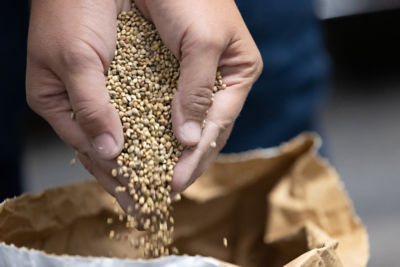Broccoli Harvest Management
» Harvest and postharvest activities for a broccoli crop require careful planning.
» A single broccoli crop is harvested two to five times during the season and may be harvested for multiple market
segments.
» The costs of harvest and postharvest activities can account for up to 60% of total production costs.
HARVEST AND PACKING PROCEDURES
Broccoli grows best under cool conditions, and in many
parts of the U. S., the crop is planted early in the spring for
an early-summer harvest. A second crop can be planted in
mid-summer for a fall harvest. In some areas, such as the
coastal regions of California, broccoli is grown year-round.1,2
Several harvest methods are used including harvesting and
bunching 8-inch long heads, crown-cuts of heads with
shorter stems, harvesting florets, and harvesting for broccoli
slaw or processing/freezing.1 Individual fields are harvested
two to five times during the season in three- to four-day
intervals. The number of harvests depends on the market
price and product quality, and a single field may be
harvested several times for different purposes.1,2,3,4
Harvested heads should be checked for worms and graded
for head size and bead tightness (Figure 1).2
 Figure 1. Crown-cut broccoli packed in a shipping carton. Gerald Holmes, California Polytechnic State University at San Luis Obispo, Bugwood.org.
Figure 1. Crown-cut broccoli packed in a shipping carton. Gerald Holmes, California Polytechnic State University at San Luis Obispo, Bugwood.org.
Optimally within four hours of harvest, broccoli should be
quickly cooled to preserve quality and shelf-life. Top-icing of
packed boxes, hydro-cooling, liquid-icing, and forced-air
cooling are all methods used to lower the temperature of
broccoli heads or florets. With liquid-icing, an ice-water
slurry is injected into filled boxes to distribute ice
throughout the box (Figure 2).3 With top-icing approximately
one pound of ice is added to the top of a packed box (Figure
3) shortly after harvest and again at the time of shipping,
usually within two days.4,5 Once cooled, broccoli should be
stored at 32 °F with relative humidity levels above 95%.
These storage conditions typically result in a shelf-life of 21-
to 28-days.2,3
 Figure 2. A liquid-icing system for broccoli. Gerald Holmes, California Polytechnic State University at San Luis Obispo, Bugwood.org.
Figure 2. A liquid-icing system for broccoli. Gerald Holmes, California Polytechnic State University at San Luis Obispo, Bugwood.org.
 Figure 3. A carton of broccoli that has been top-iced. Gerald Holmes, California Polytechnic State University at San Luis Obispo, Bugwood.org.
Figure 3. A carton of broccoli that has been top-iced. Gerald Holmes, California Polytechnic State University at San Luis Obispo, Bugwood.org.
COST CONSIDERATIONS
Costs associated with harvest and postharvest activities
usually account for 40 to 60% of the total production costs.
Costs will vary by region and depend on availability of labor,
state and local regulations, and methods of harvest and
packing (Table 1).5

Labor
Harvest and packing operations are labor intensive, and they
require careful planning and management efforts. Workers
are needed for harvesting, machine operation of harvest
equipment, grading, and packing.5 Hourly rates vary, but
experienced machine operators are usually paid at a higher rate
than the general labor used for harvest, grading, and packing.1
A typical harvest operation requires 14 non-operator
workers and one operator worker. It takes an average of
75 person-hours to harvest 450 boxes per acre.5 When
planning for applicable labor expenses, costs for state and
federal payroll taxes, worker’s compensation, and other
possible benefits should be included.1 Some growers
choose to use a farm labor contractor or the guest-worker
visa program. With these options expenses such as housing,
meals, transportation, and other required aspects may need
to be included in the labor costs.
Another labor-related expense is the cost of field sanitation,
including portable toilets, handwashing stations, separate
sources of drinking water, etc. Attention to worker hygiene is
necessary to prevent the contamination of produce with
human pathogens, and to comply with applicable laws and
regulations.1
Non-labor Costs
Other variable costs associated with harvest and packing
processes include fuel for harvest machinery and
transportation, packing boxes (approximately $1 to $2 per
box), and cooling and storage costs (approximately $1 to $2
per box) (Table 2).1,2

SOURCES
1 Tourte, L., Smith, R., Murdock, J., and Sumner, D. 2017. Sample costs to produce and harvest broccoli: Central coast region. University of California Agriculture and Natural Resources, Cooperative Extension and Agricultural Issues Center, and UC Davis Department of Agricultural Resource Economics.
2 Orzolek, M., Lamont, W., Kime, L., Harper, J. 2012. Broccoli production. Agricultural Alternatives. Penn State Extension. UA280.
3 LeStrange, M., Cahn, M., Koike, S., Smith, R., Daugovish, O., Fennimore, S., Natwick, E., Dara, S., Takele, E., and Cantwell, M. 2010. Broccoli production in California. UC Vegetable Research and Information Center. Vegetable Production Series. Publication 7211.
4 Reiners, S., Bellinder, R., Curtis, P., Helms, M., Landers, A., McGrath, M., Nault, B., and Seaman, A. 2017. Cornell integrated crop and pest management guidelines for commercial vegetable production.
5 Atallah, S. and Gómez, M. 2013. Eastern broccoli crop budgets. Cornell University. EB 2013-14.
ADDITIONAL INFORMATION
For additional agronomic information, please contact your local seed representative. Developed in partnership with Technology Development & Agronomy by Monsanto.
Individual results may vary, and performance may vary from location to location and from year to year. The information provided in this communication may not be an indicator of results you may obtain as local conditions and regulations may vary. The recommendations in this article are based upon information obtained from the cited sources and should be used as a quick reference for information about broccoli production practices. The content of this article should not be substituted for the professional opinion of a producer, grower, agronomist, economist, and similar professional dealing with this specific crop. SEMINIS DOES NOT WARRANT THE ACCURACY OF ANY INFORMATION OR TECHNICAL ADVICE PROVIDED HEREIN AND DISCLAIMS ALL LIABILITY FOR ANY CLAIM INVOLVING SUCH INFORMATION OR ADVICE. 170826144356 101817DME
Seminis® is a registered trademark of Seminis Vegetable Seeds, Inc. © 2016 Seminis Vegetable Seeds, Inc.



